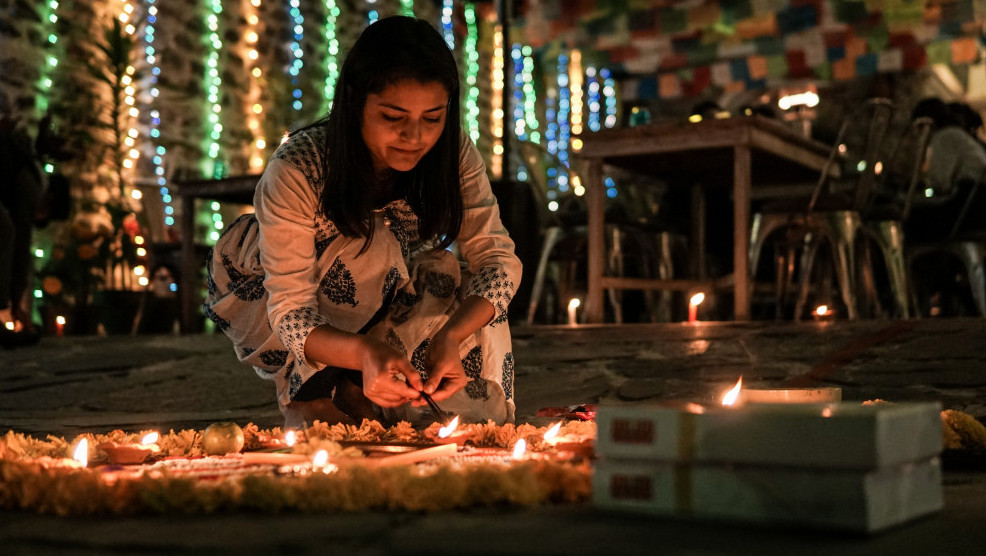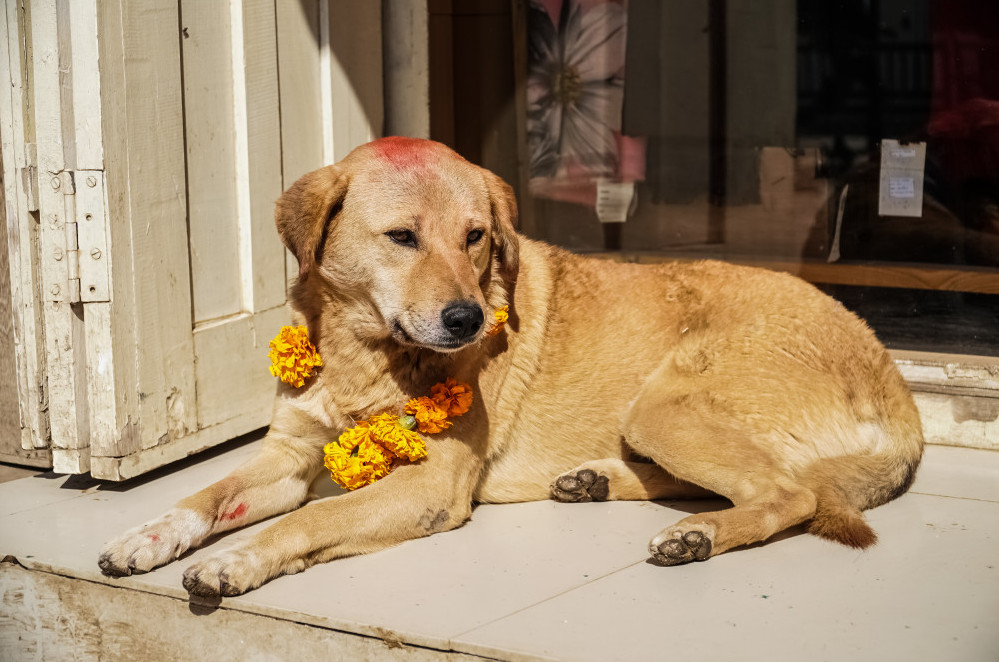 Tihar is the five-day festival of lights, worshipping Laxmi, the Goddess of wealth. Houses are lit with lights which makes it a very enjoyable festival to watch as well. You will find houses decorated with all types of combinations of flashing lights, or traditional diyos and candles.
Tihar is the five-day festival of lights, worshipping Laxmi, the Goddess of wealth. Houses are lit with lights which makes it a very enjoyable festival to watch as well. You will find houses decorated with all types of combinations of flashing lights, or traditional diyos and candles.
The festival usually starts with worshipping Ganesh, the elephant-headed god of prosperity. The following days, worshipping of the crow, dog, goddess of wealth Laxmi, the cow and bull is done, followed by Bhai Tika, in which sisters pray for the long life of their brothers.
Crows, dogs, and bulls are given Tihar celebration days to themselves as they are messengers of Yama, the god of death, so they must be satisfied.
There are some variations among the different communities in Nepal on how they celebrate Tihar. Generally, all make patterns on the floors of living rooms or courtyards using colored rice, dry flour, colored sand or flower petals, called Rangoli, which serves as a sacred welcoming area for gods and goddesses, particularly Laxmi. All communities also include the Bhai Tika in their celebrations.
Kag (Crow) Tihar and Kukur (Dog)Tihar (1st and 2nd day)
The first day of Tihar is known as “Kag Tihar”, crows day, when they are offered food in the morning on a plate made of leaves, before anyone in the house has taken breakfast. Crows are the messengers of Yamaraj, the god of death.

The second day is called “Kukur Tihar” or dogs day. The dog is seen as a guardian of the house. A big red tika is put on the dog’s forehead and a nice garland.
Laxmi Puja and Guru Puja (3rd and 4th day)
Laxmi Puja on the third day is the most important one of the Tihar festival, when the goddess of wealth, Laxmi, is worshipped. Early in the morning on this day the cow is worshipped. A Tika is put on her hand and a garland around her neck, and food is offered to her. The cow symbolizes wealth and is the most holy animal in Hinduism. Threads are tied to the cow’s tail to make the journey of the soul to the afterlife easier.
In the evening the goddess Laxmi is worshipped. During the days before the puja the house is cleaned and decorated. In the evening a Mandala is painted in from of the house with an oil lamp lit on it. From there, a pathway is made. Once the puja rituals are over, people start gambling in the house, which is allowed on this day. Laxmi Puja marks the end of the accounting year for more religious business people.
On the fourth day, “Guru puja” (ox worshipping) is typically performed. On this day, “Dause” groups of boys go from house to house singing songs
The indigenous population of the Kathmandu valley (Newars) celebrate Mha Puja on the fourth day, worshipping their own self with varieties of sweets, fruits, flowers, eggs, fish etc. The “self’ is worshipped for longevity and healthy life. It is also the start of the Newar New Year.
Bhai Tika (5th day)
Bhai Tika is celebrated on the fifth day of Tihar. The story behind Bhai Tika is that a girl received a hint from Yama that her brother would not be harmed until his garland of flowers dried and the line she drew around him vaporized. So when Yama came to claim the soul of her brother she already had him surrounded with a circle of oil and put a garland of betel flowers for his protection, and Yama had no other option than to prolong his life.
Sisters apply a sacred Tika on their brothers’ forehead and pray to Lord Yama (the God of Death) for his long life and prosperity. On this day, sisters invite their brother and his family to their house. Following the rituals of Bhai Tika, the sister then draws three Mandaps at a selected place in from of their brother. These Mandaps symbolize Lord Ganesh, Janmaraj (the God of Birth) and Yamaraj. A Puja is then performed for the deities while her brother is sitting in front of her on a mat. In Nepali culture, the Tika applied on the forehead of the brother has five colors; red, green, blue, yellow and white. Then a garland with velvet flowers is also put around the brother’s neck to wish him longevity and good health. Brothers offer presents in return.
Tihar festival food
Sweets are prominently there during Tihar and the choice is quite rich.
Sel roti is a home-made circular-shaped bread prepared during Tihar. It is made of rice flour with some added flavors. Ingredients include cardamon and clove and other flavors of personal choice.
Apart from sel roti, chini roti is also popular Tihar food. Although it is sweet (chini means sugar), it goes well with homemade pickle or with meat items.
Lakhamari is particularly consumed among the Newari community and one of the most important sweets for a lot of communities during Tihar. It is very hard to bite, but once you are able to bite it, the taste is sugary and savory at the same time.
Importance of Tihar
Tihar is the second biggest festival in Nepal, after Dashain. It is an important festival in Nepal as it celebrates moving away darkness with light and defeating evil with goodness. The festival is unique in the sense that it shows admiration not just to the gods but also to animals, who are honored because of their sacred and unique bond with humans.
Tihar is similar to the Indian festival of Diwali, as they are both considered as the festival of lights but Tihar includes the celebration and worship of the four creatures associated with the Hindu god of death (Yama).
The Bhai Tika is an event that brothers and sisters are looking forward as an annual highlight of their sibling bond. They value it highly because of its cultural and religious importance. Brothers from all around the world get home to Nepal to tika from their sisters.
